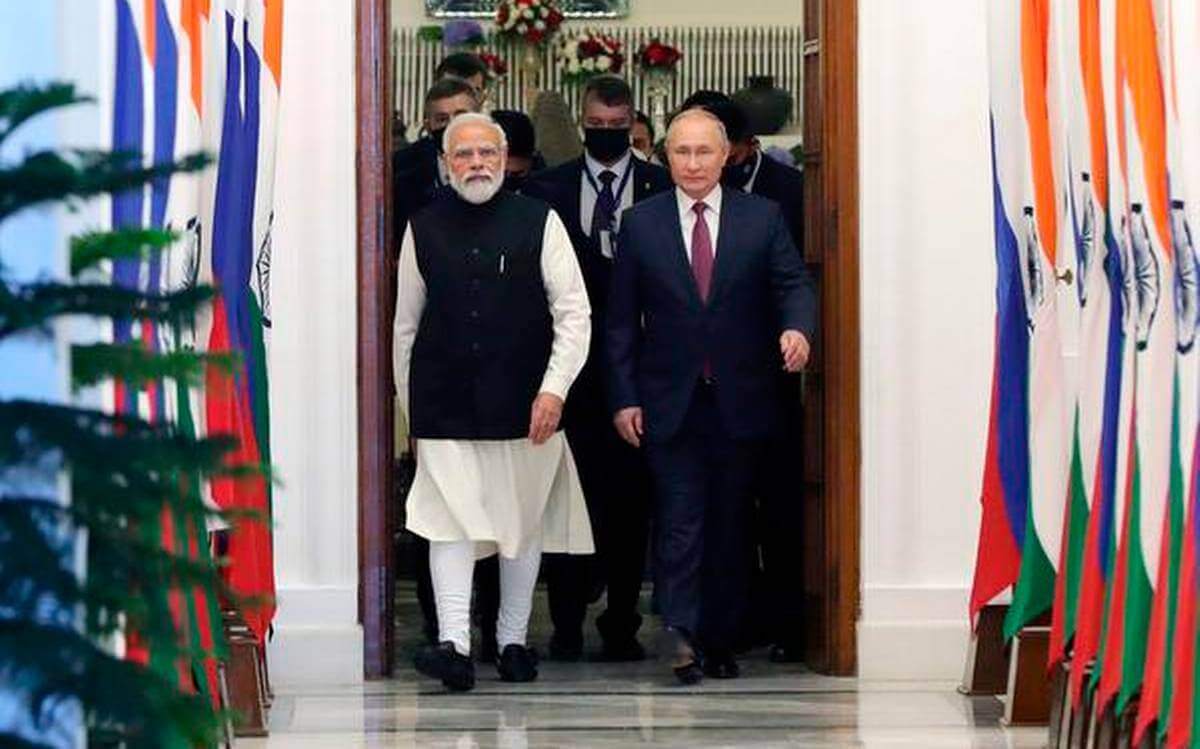On Monday, Indian Prime Minister (PM) Narendra Modi hosted Russian President Vladimir Putin at the Hyderabad House in New Delhi for talks on expanding strategic and defence ties between the two countries. Their meeting followed the landmark agreements reached between the countries’ foreign and defence ministers a day earlier.
I warmly thank H.E. President Putin for his visit to India. We exchanged very useful ideas for expanding our strategic, trade & investment, energy, connectivity, defence, science & technology and cultural cooperation. We also shared views on important global and regional issues. pic.twitter.com/FQGFgQzsfX
— Narendra Modi (@narendramodi) December 6, 2021
#NewDelhi: Russian-Indian talks @narendramodi https://t.co/67HTeFAcGg pic.twitter.com/hg3oeoKsWg
— President of Russia (@KremlinRussia_E) December 6, 2021
Putin was accompanied by a high-level delegation, including Defence Minister Sergey Shoygu and Foreign Minister Sergey Lavrov, who participated in the 2+2 dialogue with their Indian counterparts Rajnath Singh and S. Jaishankar. The meetings come at a time when India is seeking to secure its borders with Pakistan and China but also expand its footprint, both in the Indo-Pacific and in the world at large. At the same time, India seeks to counterbalance China and Russia’s growing strategic convergence.
Just completed the first ever 2+2 meeting with Russia.
— Dr. S. Jaishankar (@DrSJaishankar) December 6, 2021
A productive exchange of perspectives on cross-cutting and inter-related issues.
Will be reporting it to the Annual Summit later today. pic.twitter.com/WvMxsIl2GI
Following the summit between Modi and Putin, the two countries adopted a joint statement titled “Russia-India: Partnership for Peace, Progress, and Prosperity.” The leaders hailed their advanced “Special and Privileged Strategic Partnership,” and Putin celebrated India as a “great power” and a long-standing ally. To this end, Putin highlighted India and Russia’s unique and time-tested military and defence partnership.
Meanwhile, Modi called for greater cooperation on the Afghanistan crisis and other regional issues. He further said that India and Russia must use multilateral forums such as the non-Aligned Movement, the Indian Ocean Rim Association, the Vladivostok summit, and the Eastern Economic Forum to further emphasise that India and Russia “have identical views on all the regional and global issues.” Aside from greater defence and strategic ties, the Indian leader also outlined an objective of reaching $30 billion in trade and $50 billion in investment by 2025.
The duo also celebrated the first 2+2 meeting held on Sunday. In his opening statement at the meeting, Foreign Minister Lavrov said the forum would act as an “effective dialogue platform” for both sides to further their already flourishing friendship. Subsequently, the Indian and Russian delegations signed 28 pacts and nine government-to-government agreements. One of the significant agreements included expanding cooperation in technological protection due to their collaboration in space research.
The 2+2 meeting also produced several defence agreements, such as the intergovernmental Military-Technical Cooperation Programme for 2021-2031, which outlines the path for their defence ties over the next decade.
Furthermore, officials signed a protocol to amend the 2019 intergovernmental agreement on Kalashnikov rifles. India will now produce more than 600,000 AK-203 rifles, making the deal worth over Rs 5,000 crore ($663 million). Russia also expressed an interest in providing India with additional S-400 air defence systems. As per their 2018 agreement, worth $5.5 million, Russia agreed to provide India with five S-400 regiments, the delivery of which has already begun.
The meeting also saw a discussion on the situation in the increasingly unstable Indo-Pacific region. In this regard, Lavrov said that the setting up of exclusive mechanisms like the AUKUS military alliance between Australia, the United States, and the United Kingdom was creating more conflict in the region. He said that partnerships like the AUKUS undermined the universal and inclusive nature of cooperation in the Association of Southeast Asian Nations (ASEAN).
Furthermore, the two sides signed agreements to bolster cooperation in trade, energy, intellectual property, geological exploration, science, technology, and innovation. They also agreed to promote people-to-people ties through cultural exchanges and cooperation in education.
In furtherance of the agreements made during the 2+2 meeting, Modi and Putin agreed to “predictable and sustainable economic cooperation” through mutual investments. They also discussed the importance of the International North-South Transport Corridor and the proposed Chennai-Vladivostok Eastern Maritime Corridor.
Apart from this, the duo discussed the need to cooperate on regional and global issues, including the Afghanistan humanitarian crisis and reforming multilateral institutions.
The United States (US) has previously hinted at sanctions if India goes through with the S-400 deal with Russia. Washington has suggested that it may invoke the Countering Americas Adversaries Through Sanctions Act (CAATSA), which seeks to deter American allies from purchasing defence equipment from Russia and other adversaries. In fact, the US has already sanctioned Turkey for the purchase of the same equipment.
Owing to this pressure, India has previously sought to reduce its reliance on Russian weapons. From 2016 to 2020, there was a 53% drop in Russian arms exports to India. Simultaneously, its defence ties with the US increased via bilateral engagements and multilateral groups like the Quadrilateral Security Dialogue, with arms sales hitting $3.4 billion in 2020. However, this week’s meetings indicate India’s increased strategic and defence ties with Russia and illustrate how New Delhi is looking to maintain an independent foreign policy, despite being aligned with the West on several issues.

